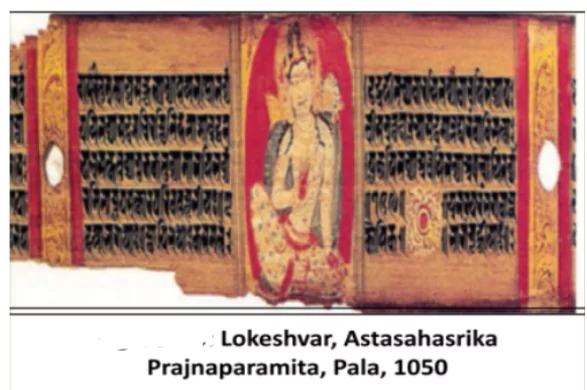Introduction
The earliest examples of miniature painting in India exist in the form of illustrations to the religious texts on Buddhism executed under the Palas of eastern India and the Jain texts executed in western India during the 11th-12th centuries A.D. During the 11th century AD, a new method of expression emerged in the form of miniature paintings on palm leaves and paper.
Features of Miniature Painting
- The painting’s size must not exceed 25 square inches.
- Traditional tempera technique used for these paintings.
- Human figures are typically depicted in a side profile, exhibiting prominent features such as bulging eyes, pointed noses, and slender waists.
- Materials Used: Palm leaf, paper, wood, and cloth
Enroll now for UPSC Online Course
The Pala School

- Illustrated manuscripts of the Palas of Eastern India during the 11th and 12th centuries AD have earliest examples of paintings of this school.
- From 750 AD to 1150 AD, the Palas illustrated Buddhist texts mostly on materials like palm leaves or vellum paper.
- Notable painters: Dhimman and Vitapala.
Features:
- Paintings were dominated by Buddhist imagery.
- An example of a Pala Buddhist palm leaf manuscript is the “Astasahasrika Prajnaparamita”, also known as the ‘Perfection of Wisdom’.
- This was created at the Nalanda monastery during King Ramapala’s reign in the eleventh century
- These paintings often feature solitary figures, and it is rare to encounter group compositions.
Apabhramsa School Of Art
- It is also known as the Jain School of Art and Western Indian style of painting, which prevailed in the region comprising Gujarat, Rajasthan and Malwa.
- The artistic activity in Western India was influenced by Jainism as it was patronised by the Chalukyas of Gujarat or Solanki, who ruled Gujarat, parts of Rajasthan and Malwa.
- These paintings were dominated by Jain iconography.
- Jain paintings saw growth due to the concept of “shaastradaan” (donation of books). Donating illustrated paintings to monastery libraries or “bhandars” was seen as a noble act of charity.
- Examples: Kalpasutra, Uttaradhyayana Sutra, Sangrahani Sutra and the Kalakacharya Katha from the 15th century.
Other Miniature Paintings:
- The Nimat Nama Manuscript (Cookery Book) reflects a new trend of painting in Malwa. It was started during the reign of Ghiyasuddin Khilji of Malwa (1469-1500 AD)
- “Kulhadar Group” (Early 16th Century): This group includes illustrations of various texts like the ‘Chaurapanchasika,’ ‘Gita Govinda,’ ‘Bhagavata Purana,’ and ‘Ragamala.’
- Two manuscripts of the ‘Laur Chanda,’ an Avadhi romance by Mulla Daud, created between 1530 to 1540 AD, show a blend of Persian and Indian styles.
Enroll now for UPSC Online Classes
Conclusion
- Indian miniature painting continues to captivate with its timeless beauty, serving as a testament to the country’s artistic legacy and cultural heritage cherished by enthusiasts worldwide.
![]() April 10, 2024
April 10, 2024
![]() 3499
3499
![]() 0
0
